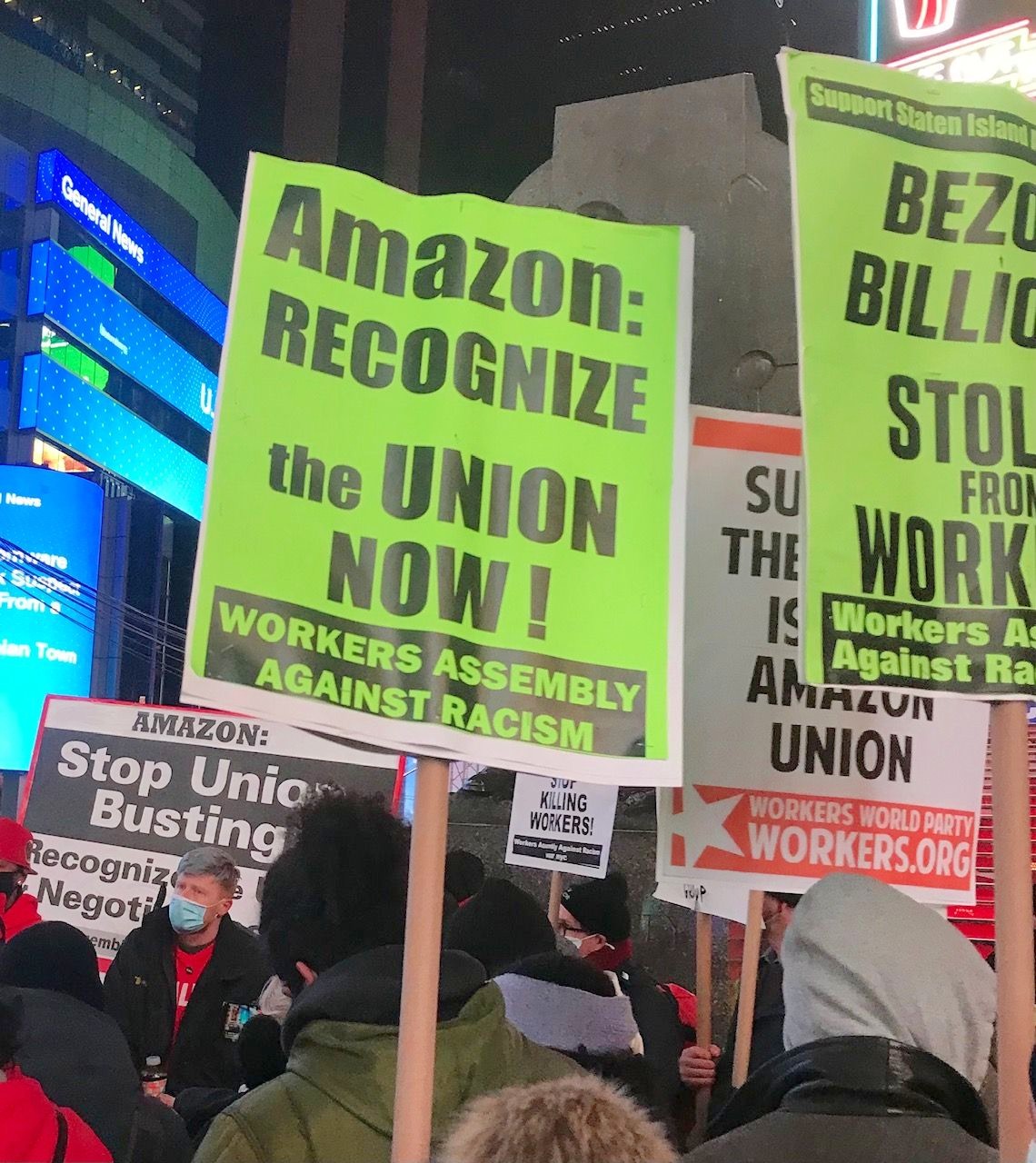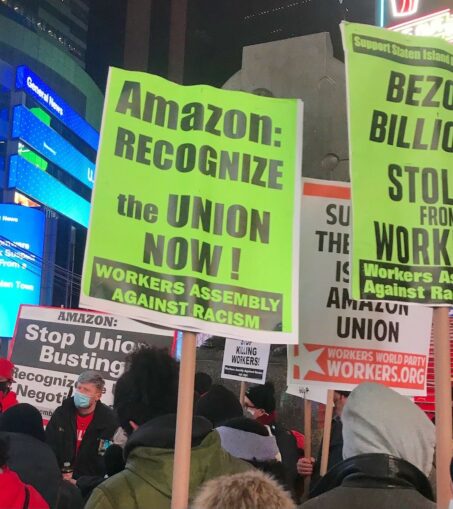

Times Square, New York City, Dec. 22, 2021.WW Photo: Tony Murphy
This article was written for an international end-of-year collection and published in French and Spanish translations on lapluma.net and tlaxcala-int.blogspot.com.


Times Square, New York City, Dec. 22, 2021.WW Photo: Tony Murphy
Workers at three Amazon locations have opened drives to form a union in this mammoth corporation that employs over 1 million workers in the U.S. alone. Workers at two Starbucks cafes in Buffalo, New York, have won union representation in a vote.
Amazon and pro-union supporters held protests in the U.S., Western Europe and Bangladesh on Nov. 26 — so-called Black Friday — at Amazon warehouses to demand workers’ rights and union rights. The actions focused on logistics workers in the U.S. and Europe and textile production workers in Bangladesh.
Other actions are planned for Jan. 12, birthday of the centibillionaire top boss of Amazon, Jeff Bezos, and for the Rev. Dr. Martin Luther King Jr. holiday. (supportamazonworkers.org/jan12/)
This may seem like a small beginning. Still, it has already raised the hopes of millions of workers in the U.S. and thousands of union activists that something big is underway. It has raised the hopes of worker organizers of reversing the decline in union membership over the past 68 years.
Some voices, ang communists and unionists, and among observers in the corporate media, have referenced the upsurge of the CIO industrial union in the 1930s and are asking if a new wave might be coming.
The New York Times and The Boston Globe, for example, have run feature articles on the Starbucks and Amazon organizing drives with big headlines and mentioned the 1930s. The Times normally confines labor news to the business section. Most articles are about strikes that were lost or splits between rank-and-file workers and union leaders.
In the fall of 2021, unionized workers in the U.S. struck more often than they had for decades. In the big strikes at Kellogg’s cereal manufacturers and John Deere tractors and bulldozers, the striking workers forced their union leaders to continue strikes after they reached agreements with the bosses.
This rapid rise in the number of workers on strike follows decades of decline in union membership. There were heroic strikes, but almost all were lost by the unions.
Decline of union membership
Following an expansion of unionization from the late 1930s to the mid-1950s, nearly 35% of U.S. workers belonged to unions. Unions were especially strong in heavy industry: steel, coal, auto manufacturing, where they wrested better contracts from their world-dominant bosses.
The bosses and government struck at labor first with the Taft-Hartley Act of 1947 that severely curtailed organizing and banned a number of effective strike tactics. The Cold War attack on communists forced the best political organizers out of the unions.
Then deindustrialization of the U.S. economy replaced workers with machines and moved industry to lower-wage regions using new production methods. The unionized workforce retired or were permanently laid off. The new jobs were often in service industries, logistics, health care and education.
The federal government waged an all-out attack on the air traffic controllers when they struck in 1980. This broke the PATCO strike, beginning a sharp downturn in union strength. While heroic strikes by rank-and-file workers took place in subsequent years, few led to victories.
Deindustrialization accelerated after the collapse of the Soviet Union and the opening of the Chinese workforce to international capitalist employment. In effect, from the 1980s to 2000, the exploitable world workforce doubled from about 1.5 billion to 3 billion workers.
There was a vast army of surplus labor. Average wages decreased, as did union membership. Inequality expanded rapidly.
By 2020 unionized workers were only 10.8% of the workforce in the U.S. While the U.S. provides an extreme example, union membership fell by half or more in Japan, Europe and most imperialist countries.
Striketober
The increase in strikes and organizing takes place as the fourth wave of COVID-19 is hitting especially hard in the Midwest and Northeast of the United States. The pandemic crisis taught workers in health care, education, retail and logistics that their work is “essential” — if they hadn’t known it before.
From August through November, a record 4-million-plus workers quit their jobs each month, seeking higher wages and better conditions.
While COVID-19 slowed the overall economy, some companies mushroomed. Amazon, with a monopoly of internet sales, added 500,000 workers to its U.S. workforce in 2021 — plus another 250,000 drivers and deliverers employed by subcontractors. Amazon now employs 1.3 million workers.
Amazon treats its warehouse workers like Marines in basic training. These abuses and overwork cause an enormously high turnover rate: 3% each week or about 150% each year. While this turnover requires constant hiring, management accepts it, because their brutal methods keep exploitation and profits high.
Amazon’s workforce is young; many workers are African American or Latinx. All are angry and more than ever aware of their class oppression. They are aware that their jobs fail to pay a living wage.
They are aware Amazon’s bosses — and those at Starbucks, Walmart and others — will break every rule to keep their companies from being unionized.
They are aware more than ever that those who dominate the U.S., but can’t control a virus, won’t stop the global climate crisis. They experienced an unprecedented wave of tornadoes that killed workers in an Illinois Amazon warehouse, who were forced to stay on the job in December or face discipline.
Amazon workers are aware that their big boss Bezos has used money he took from their labor to finance a joyride to the stratosphere.
The hope of organizers is that the small victories at Starbucks will lead to bigger ones at Amazon and spread through the U.S. working class faster than the pandemic. It’s a big step that hasn’t taken place yet, but one can’t be a worker organizer, let alone a revolutionary, without being an optimist.
This can impact the workers’ struggle worldwide. Jeff Bezos may wish he had stayed in the stratosphere.
Some of the labor history and economic data in this article is from ‘Low Wage Capitalism — Colossus With Feet of Clay’ by Fred Goldstein (World View Forum, 2008).
Download the PDF May Day appeal to the working class Revolutionary change is urgent! Gaza…
Philadelphia On March 26, the Pennsylvania Supreme Court denied political prisoner Mumia Abu-Jamal permission to…
There are two important and overlapping holidays on April 22: Earth Day and Vladimir Lenin’s…
Twelve people were arrested April 9 for blocking traffic to Travis Air Force Base, a…
Secretary-General of Hezbollah Sheikh Naim Qassem delivered a speech on April 18, 2025. Resistance News…
Anakbayan Philadelphia held a rally on April 19 to demand the U.S. end its military…